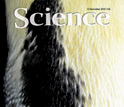News Release 10-215
Key Player in Detoxification Pathway Isolated After Decades of Searching
Future studies of P450 compound I could lead to the more efficient design and creation of drugs

The P450 family of enzymes metabolize of about 75 percent of known pharmaceuticals.
November 12, 2010
This material is available primarily for archival purposes. Telephone numbers or other contact information may be out of date; please see current contact information at media contacts.
Chemical reactions are happening all over the place all the time--on the sun, on the Earth and in our bodies. In many cases, enzymes help make these reactions occur. One family of enzymes, called cytochrome P450s (P450), is important because they help us eliminate toxins.
We know P450s are important to life of all kinds because they have been found in animals, plants, fungi and bacteria, but they are of special interest to humans because they are responsible for metabolism of about 75 percent of known pharmaceuticals.
"The reactions that P450s perform to detoxify a compound are interesting because they activate chemical bonds that are usually not reactive. Chemically speaking, this is a very difficult thing to do in a controlled way," said Michael Green of the department of chemistry at Penn State University. Green and a former student are authors of a paper describing a breakthrough in isolation of P450 compound I, an important chemical intermediate in the process of drug metabolism. This research, supported by the National Science Foundation, appears in the November 12 issue of the journal Science.
In terms of P450s, we humans aren't all the same. One person can be susceptible to poisoning by a toxin or drug more than another based on the levels of the different P450s they have in their liver, lungs and other organs. With such obvious medical and biological importance, these enzymes have been studied in great detail for many years, but exactly how they are able to catalyze these chemical reactions remains to be determined.
At the heart of the problem is P450 compound I. It is a highly reactive chemical species produced by the P450 enzyme to help metabolize a toxin or drug. Because of this extreme reactivity, compound I turns into something else before scientists have a chance to capture it. This has remained a problem for more than 40 years, prompting some to question its very existence.
"This work confirms the existence of compound I, and demonstrates that it can perform the type of chemical reactions for which P450s are known," stated Green. "Now that we can make this chemical species, we can begin to do larger scale studies to understand just how it performs this chemistry."
The research has impact on two major fronts: medicine and basic chemistry. A better understanding of both the biology and chemistry of this family of enzymes will drive research in both fields. Eventually, Green hopes these insights will help chemists understand how to better control the specificity of a given chemical reaction. This knowledge could make production of pharmaceuticals and a variety of commodity chemicals cheaper and more efficient.
-NSF-
-
This work is featured in the November 12, 2010 issue of Science.
Credit and Larger Version
Media Contacts
Lisa Van Pay, NSF, (703) 292-8796, email: lvanpay@nsf.gov
Barbara Kennedy, Penn State University, (814) 863-4682, email: science@psu.edu
Program Contacts
David Alexander Rockcliffe, NSF, (703) 292-7123, email: drockcli@nsf.gov
Principal Investigators
Michael Green, Penn State University, (814) 863-0925, email: mtg10@psu.edu
The U.S. National Science Foundation propels the nation forward by advancing fundamental research in all fields of science and engineering. NSF supports research and people by providing facilities, instruments and funding to support their ingenuity and sustain the U.S. as a global leader in research and innovation. With a fiscal year 2023 budget of $9.5 billion, NSF funds reach all 50 states through grants to nearly 2,000 colleges, universities and institutions. Each year, NSF receives more than 40,000 competitive proposals and makes about 11,000 new awards. Those awards include support for cooperative research with industry, Arctic and Antarctic research and operations, and U.S. participation in international scientific efforts.
Connect with us online
NSF website: nsf.gov
NSF News: nsf.gov/news
For News Media: nsf.gov/news/newsroom
Statistics: nsf.gov/statistics/
Awards database: nsf.gov/awardsearch/
Follow us on social
Twitter: twitter.com/NSF
Facebook: facebook.com/US.NSF
Instagram: instagram.com/nsfgov



